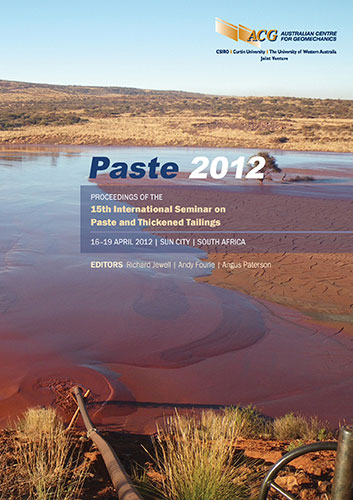Thickened tailings – a water and energy consumption perspective

|
Authors: Möller, JHL; Paterson, AJC; Verbeek, T |
DOI https://doi.org/10.36487/ACG_rep/1263_18_Moller
Cite As:
Möller, JHL, Paterson, AJC & Verbeek, T 2012, 'Thickened tailings – a water and energy consumption perspective', in R Jewell, AB Fourie & A Paterson (eds), Paste 2012: Proceedings of the 15th International Seminar on Paste and Thickened Tailings, Australian Centre for Geomechanics, Perth, pp. 213-224, https://doi.org/10.36487/ACG_rep/1263_18_Moller
Abstract:
A bench-scale thickening and rheology test campaign was conducted on iron ore tailings material originating from a pilot plant for a potential concentrates beneficiation project situated in the Northern Cape province of South Africa. The purpose of this study was to determine the optimum thickened target density for the slimes generated by the pilot plant by considering both water and energy consumption. A water and energy consumption model was developed to indicate at which thickened density the optimum water recovery and energy consumption cost benefit is obtained. The model indicates that for the pilot plant tailings material, water consumption is reduced by thickening up to an optimum density where after energy consumption increases exponentially and – considering the current ratio between the cost of water and the cost of electricity – the water consumption economic benefit is lost.
References:
Vietti, A.J., Boshoff, J.C.J. and Cope, A. (2010) Does thickening save water?, in Proceedings Fourth International Platinum Conference Platinum In Transition ‘Boom or Bust’ 2010, 11–14 October, Sun City, South Africa, The Southern African Institute of Mining and Metallurgy, Johannesburg, Symposium Series S63, pp. 7–11.
© Copyright 2025, Australian Centre for Geomechanics (ACG), The University of Western Australia. All rights reserved.
View copyright/legal information
Please direct any queries or error reports to repository-acg@uwa.edu.au
View copyright/legal information
Please direct any queries or error reports to repository-acg@uwa.edu.au